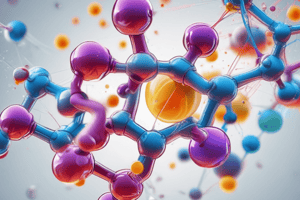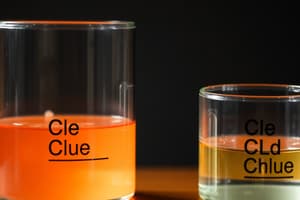Podcast
Questions and Answers
Which of the following statements correctly identifies a characteristic of neutral solutions?
Which of the following statements correctly identifies a characteristic of neutral solutions?
- Neutral solutions release hydroxide ions.
- Neutral solutions do not react with acids.
- Neutral solutions have a pH greater than 7.
- Neutral solutions always have a pH of 7. (correct)
What is a criterion for identifying a substance as an acid?
What is a criterion for identifying a substance as an acid?
- It neutralizes bases to produce salt.
- It has a pH greater than 7.
- It releases hydroxide ions in solutions.
- Its formula starts with hydrogen. (correct)
Which reaction correctly represents the neutralization process?
Which reaction correctly represents the neutralization process?
- Acid + Base = Salt + Water (correct)
- Base + Base = Salt + Water
- Acid + Acid = Salt + Water
- Base + Base = Acid + Water
Which of the following is an example of a substance that acts as a base?
Which of the following is an example of a substance that acts as a base?
How can one identify that a compound is a base based on its chemical behavior?
How can one identify that a compound is a base based on its chemical behavior?
What role does H₂O play in neutralization reactions?
What role does H₂O play in neutralization reactions?
Which of the following statements about acids is true?
Which of the following statements about acids is true?
In the reaction of NaCl formation, which statement is correct?
In the reaction of NaCl formation, which statement is correct?
How does ammonia (NH₃) function as a base?
How does ammonia (NH₃) function as a base?
Which of the following best describes the properties of bases?
Which of the following best describes the properties of bases?
What is the primary reason that ammonia is classified as a weak base?
What is the primary reason that ammonia is classified as a weak base?
Which statement accurately describes the behavior of ammonium ions ($NH_4^+$) in a solution of ammonia?
Which statement accurately describes the behavior of ammonium ions ($NH_4^+$) in a solution of ammonia?
How does the reaction of a strong base differ from that of a weak base when dissolved in water?
How does the reaction of a strong base differ from that of a weak base when dissolved in water?
In the presence of an acid, how do amphoteric oxides behave?
In the presence of an acid, how do amphoteric oxides behave?
What role does water play in the reaction of ammonia in forming hydroxide ions?
What role does water play in the reaction of ammonia in forming hydroxide ions?
What is the key characteristic of metal carbonates in comparison to metal oxides?
What is the key characteristic of metal carbonates in comparison to metal oxides?
What must be true about the reactants in a precipitation reaction?
What must be true about the reactants in a precipitation reaction?
Which of the following combinations would NOT yield a precipitate?
Which of the following combinations would NOT yield a precipitate?
In the example reaction $AgNO_3(aq) + NaCl(aq) \rightarrow AgCl(s) + NaNO_3(aq)$, which product is insoluble?
In the example reaction $AgNO_3(aq) + NaCl(aq) \rightarrow AgCl(s) + NaNO_3(aq)$, which product is insoluble?
What defines a precipitate in a chemical reaction?
What defines a precipitate in a chemical reaction?
What is the primary product of thermal decomposition?
What is the primary product of thermal decomposition?
What typically characterizes combustion reactions?
What typically characterizes combustion reactions?
Incomplete combustion occurs primarily because of which factor?
Incomplete combustion occurs primarily because of which factor?
Which of the following statements is true regarding the products of combustion?
Which of the following statements is true regarding the products of combustion?
Which reaction is likely to occur during incomplete combustion?
Which reaction is likely to occur during incomplete combustion?
How is the number of neutrons in an atom calculated?
How is the number of neutrons in an atom calculated?
What is the correct representation of the formula for calculating concentration?
What is the correct representation of the formula for calculating concentration?
Which statement accurately describes an isotope?
Which statement accurately describes an isotope?
Which of the following ions has a two negative charge?
Which of the following ions has a two negative charge?
What does the Period of an element indicate within the periodic table?
What does the Period of an element indicate within the periodic table?
What is the primary reason that magnesium can displace iron from iron(II) sulfate in a displacement reaction?
What is the primary reason that magnesium can displace iron from iron(II) sulfate in a displacement reaction?
In a displacement reaction, which of the following statements is true about the reactivity of elements involved?
In a displacement reaction, which of the following statements is true about the reactivity of elements involved?
If the initial reaction of magnesium with iron(II) sulfate is expressed as Mg(s) + FeSO₄(aq) → MgSO₄(aq) + Fe, what type of reaction is this?
If the initial reaction of magnesium with iron(II) sulfate is expressed as Mg(s) + FeSO₄(aq) → MgSO₄(aq) + Fe, what type of reaction is this?
Which of the following best describes the relationship between the number of electrons gained or lost and reactivity?
Which of the following best describes the relationship between the number of electrons gained or lost and reactivity?
Which pair of substances could undergo a displacement reaction based on their reactivity series positions?
Which pair of substances could undergo a displacement reaction based on their reactivity series positions?
What is a common characteristic of covalent bonds?
What is a common characteristic of covalent bonds?
In which type of reaction is heat absorbed from the surroundings?
In which type of reaction is heat absorbed from the surroundings?
What does a higher activation energy indicate about a chemical reaction?
What does a higher activation energy indicate about a chemical reaction?
Which statement about the potential energy of reactants and products is true for exothermic reactions?
Which statement about the potential energy of reactants and products is true for exothermic reactions?
Which of the following equations correctly represents the change in enthalpy for endothermic reactions?
Which of the following equations correctly represents the change in enthalpy for endothermic reactions?
Which statement about isotopes is accurate regarding their physical properties?
Which statement about isotopes is accurate regarding their physical properties?
What statement accurately describes ionic compounds' conductivity?
What statement accurately describes ionic compounds' conductivity?
Which of the following correctly defines ionic bonding?
Which of the following correctly defines ionic bonding?
What aspect of the conservation of mass theory is emphasized in chemical reactions?
What aspect of the conservation of mass theory is emphasized in chemical reactions?
Which is a notable property of ionic compounds?
Which is a notable property of ionic compounds?
What happens to the amount of heat absorbed or released if the mass of a substance is doubled, assuming specific heat capacity and temperature change remain constant?
What happens to the amount of heat absorbed or released if the mass of a substance is doubled, assuming specific heat capacity and temperature change remain constant?
Which of the following pairs represents a complete neutralization reaction?
Which of the following pairs represents a complete neutralization reaction?
In terms of mass and charge, how does a proton differ from a neutron and an electron?
In terms of mass and charge, how does a proton differ from a neutron and an electron?
Which unit represents the amount of energy required to increase the temperature of 1 gram of a substance by 1 Kelvin?
Which unit represents the amount of energy required to increase the temperature of 1 gram of a substance by 1 Kelvin?
If the quantity of heat transferred to a substance is represented by Q, what would happen to Q if both the mass and temperature change are halved?
If the quantity of heat transferred to a substance is represented by Q, what would happen to Q if both the mass and temperature change are halved?
Flashcards
Neutral solution pH
Neutral solution pH
A neutral solution has a pH of 7.
Acid indicator
Acid indicator
A substance that releases hydrogen ions (H⁺) when in a solution and its formulas often starts with hydrogen.
Base
Base
A substance that releases hydroxide ions (OH⁻) when in a solution. or accepts hydrogen ions to form water.
Neutralization reaction
Neutralization reaction
Signup and view all the flashcards
Base formula example
Base formula example
Signup and view all the flashcards
Acid Donation
Acid Donation
Signup and view all the flashcards
Base Acceptance
Base Acceptance
Signup and view all the flashcards
Water: Acid or Base?
Water: Acid or Base?
Signup and view all the flashcards
Ammonia Exception
Ammonia Exception
Signup and view all the flashcards
Ammonia's Base Behavior
Ammonia's Base Behavior
Signup and view all the flashcards
Weak Base vs. Strong Base
Weak Base vs. Strong Base
Signup and view all the flashcards
Metal Carbonates
Metal Carbonates
Signup and view all the flashcards
Precipitation Reaction
Precipitation Reaction
Signup and view all the flashcards
What's needed for a precipitation reaction?
What's needed for a precipitation reaction?
Signup and view all the flashcards
Precipitation Reaction Equation
Precipitation Reaction Equation
Signup and view all the flashcards
Identify the Insoluble Product
Identify the Insoluble Product
Signup and view all the flashcards
Thermal Decomposition
Thermal Decomposition
Signup and view all the flashcards
Combustion Products
Combustion Products
Signup and view all the flashcards
What is combustion?
What is combustion?
Signup and view all the flashcards
Incomplete Combustion
Incomplete Combustion
Signup and view all the flashcards
Oxygen and Combustion
Oxygen and Combustion
Signup and view all the flashcards
Displacement Reaction
Displacement Reaction
Signup and view all the flashcards
Reactivity Series
Reactivity Series
Signup and view all the flashcards
What makes an element more reactive?
What makes an element more reactive?
Signup and view all the flashcards
Single Displacement Reaction
Single Displacement Reaction
Signup and view all the flashcards
Example of Displacement Reaction
Example of Displacement Reaction
Signup and view all the flashcards
Neutron Number
Neutron Number
Signup and view all the flashcards
Isotope
Isotope
Signup and view all the flashcards
Molar Mass (Mr)
Molar Mass (Mr)
Signup and view all the flashcards
Concentration (C)
Concentration (C)
Signup and view all the flashcards
What does 'Q' represent in the equation Q = m * c * ΔT?
What does 'Q' represent in the equation Q = m * c * ΔT?
Signup and view all the flashcards
Specific Heat Capacity
Specific Heat Capacity
Signup and view all the flashcards
Heat Transfer Factors
Heat Transfer Factors
Signup and view all the flashcards
Neutralization Equation 1
Neutralization Equation 1
Signup and view all the flashcards
Subatomic Particles
Subatomic Particles
Signup and view all the flashcards
Units in Chemistry
Units in Chemistry
Signup and view all the flashcards
Covalent Bond
Covalent Bond
Signup and view all the flashcards
Properties of Covalent Compounds
Properties of Covalent Compounds
Signup and view all the flashcards
Exothermic Reaction
Exothermic Reaction
Signup and view all the flashcards
Endothermic Reaction
Endothermic Reaction
Signup and view all the flashcards
Activation Energy
Activation Energy
Signup and view all the flashcards
Isotopes: Same Chemistry?
Isotopes: Same Chemistry?
Signup and view all the flashcards
Ionic Bonding: Strong Attraction?
Ionic Bonding: Strong Attraction?
Signup and view all the flashcards
Giant Ionic Lattice
Giant Ionic Lattice
Signup and view all the flashcards
Ionic Compound Properties: Solid at Room Temperature?
Ionic Compound Properties: Solid at Room Temperature?
Signup and view all the flashcards
Conductivity: Solid vs. Solution?
Conductivity: Solid vs. Solution?
Signup and view all the flashcards




